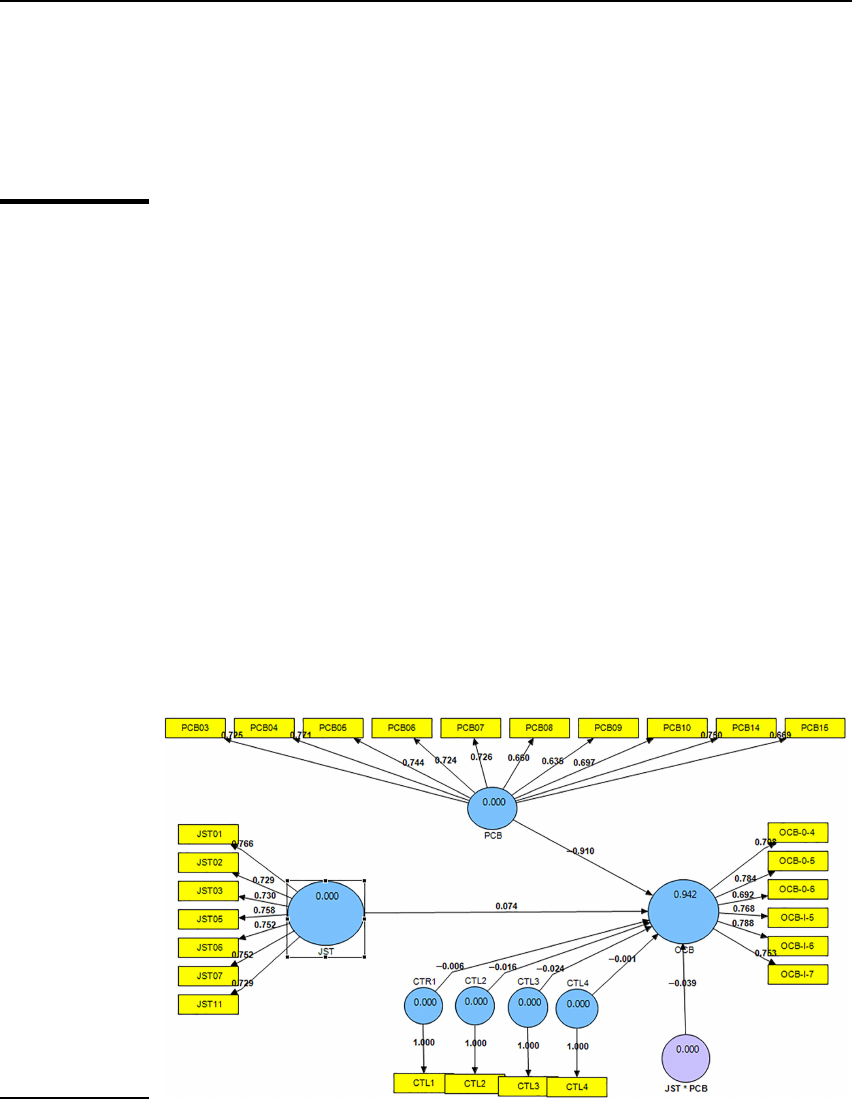
Psychological contract breach
moderates job satisfaction–
citizenship behaviour relationship
Samuel Koomson
Department of Management, University of Cape Coast, Cape Coast, Ghana
Abstract
Purpose – This study finds out if a satisfied physician will show citizenship behaviour (OCB) in a work
environment where psychological contract breach (PCB) exist.
Design/methodology/approach – Quantitative data from 214 physicians across 26 health-care units were
analysed. Research philosophy was positivism, research design was explanatory and study design was cross-
sectional. Preliminary tests were conducted. Reflective measurement and structural models were examined.
PLS algorithm tool and bootstrapping procedure were utilised. Control variables were sex, age, employment
type and tenure. A significant level was set at 5%. Smart PLS 2.0M.3 software was employed.
Findings – The scientist found support for a significant moderating effect of PCB on the nexus between job
satisfaction (JST) and OCB, such that PCB demoralised a satisfied physician in showing OCB. In contrast, a
fulfilled psychological contract motivated satisfied physicians to exhibit OCB.
Practical implications – PCB, if not addressed, may lead satisfied physicians to show low OCB, which has
devastating effects for health-care organisations and their patients. Creating balanced, fulfilled and
harmonious relationship within physicians will transform the workplace into a more meaningful and
purposeful atmosphere.
Originality/value – This study offers empirical health-care literature on the moderating effect of PCB, a
psychosocial stressor, on the direct relationship between JST and OCB, integrating and lengthening the social
exchange theory, resource-based theory and activation theory.
Keywords Work attitudes, Unfulfilled psychological contract, Discretionary behaviour, Partial least square-
structural equation modelling
Paper type Research paper
Introduction
The notion of a psychological contract (PC) implies that there is an unwritten set of
anticipations operating always between every member of an organisation and the various
managers and others in that organisation (Huy and Takahashi, 2018). Employers, on the one
hand, may expect employees to do their best on behalf of the organisation: “to put themselves
out for the company”; to be fully committed to its values, to be compliant and loyal; and to
enhance the image of the organisation with its customers and suppliers (Rousseau and
Greller, 1994). Employees, on the other hand, may expect to be treated fairly as humans, to be
offered assignments that uses their abilities, to be rewarded equitably in accordance with
their contribution, to be able to display competence, to have opportunities for further growth,
to know what is expected of them, to be given feedback-preferably positive-on how they are
doing, to be involved in decision making and to trust in the management of the organisation
to keep their promises (Guest et al., 1996). This assertion is comparable to the 8th and 16th UN
Sustainable Development Goal, which seeks to provide decent work and economic
PCB moderates
JST–OCB
relationship
© Samuel Koomson. Published in PSU Research Review. Published by Emerald Publishing Limited. This
article is published under the Creative Commons Attribution (CC BY 4.0) licence. Anyone may
reproduce, distribute, translate and create derivative works of this article (for both commercial and non-
commercial purposes), subject to full attribution to the original publication and authors. The full terms of
this licence may be seen at http://creativecommons.org/licences/by/4.0/legalcode
The current issue and full text archive of this journal is available on Emerald Insight at:
https://www.emerald.com/insight/2399-1747.htm
Received 6 July 2021
Revised 21 November 2021
Accepted 6 December 2021
PSU Research Review
Emerald Publishing Limited
2399-1747
DOI 10.1108/PRR-07-2021-0032

development for all, and promote peaceful and inclusive societies for sustainable
development respectively (Catholic Agency for Overseas Development, 2015).
Gallup’s State of the American Workplace Report (2017) upholds that employees need to
be in an environment where there is mutual trust, recognition and respect for one another’s
efforts and results. Ghana Healthcare Quality Strategy Report (2017) also asserts the need for
management to build a culture of “joy at work” in terms of financing, logistics, recognition
and rewards to give room for health professionals to deliver high quality care and be
motivated to continuously improve quality, especially in this era of Covid-19 (Nurunnabi
et al., 2020). This assertion is consistent with the mission of the Ghana Health Service (2017),
which seeks to establish a more equitable, efficient, accessible and responsive health-care
system.
A PC is said to have been honoured or fulfilled when an organisation meets its obligations
to an employee, from the employee’s vantage and it serves to build upon the social exchange
element (Karagonlar et al., 2016), which are founded on trust, reciprocation and reward (Blau,
1964). A PC is said to have been breached if an organisation fails to deliver on an expected
obligation to an employee, which can either be written or unwritten (Robinson and Rousseau,
1994). When a PC is honoured or fulfilled, employees are likely to show high level of job
satisfaction (JST). On the other hand, when a PC is in breach or unfulfilled, there is the
tendency for employees to exhibit low level of JST (Opoku Mensah and Koomson, 2021). JST
is a person’s psychological response to his work, as a result of assessment or work experience,
with proud indicators of employment, suitability of work facilities, promotion opportunities,
supervisory presence in the execution of work and the existence of colleagues who support
(Abdullah, 2018).
The negative relationship between psychological contract breach (PCB) and JST is
described by the social exchange theory (SET), which one of the most applied conceptual
paradigms for understanding workplace behaviour (Cropanzano et al., 2017). According the
SET, when the organisation helps the employee out, the employee is likely to do something in
return for the organisation. But, if the employee senses that the organisation does not have
his/her best interest at heart, the employee is likely to show undesired attitudes (Organ, 2018),
such low level of JST.
A satisfied employee presents benefits to co-workers and the organisation at large. To
illustrate, Abdullah (2018) showed a direct positive effect of JST on OCB among teachers
drawn from public vocational high schools in Indonesia. Koomson and Opoku Mensah (2020)
also uncovered a direct positive connection between JST and OCB among medical doctors in
Ghana. As such, it is said that ground-breaking transformations in organisations are a result
of satisfied employees. The connection between JST and OCB is described the resource-based
theory (RBT). The RBT regards a satisfied employee as a firm resource or asset which is able
to generate value or competitive advantage by being rare and difficult to imitate by rival
firms (Rezaei and Ortt, 2018). This competitive advantage converts to positive organisational
outcomes, in the form of discretionary behaviour for the benefit of co-workers and the
organisation itself.
The SET is also useful in explaining the negative relationship between PCB and OCB,
such that when an employee’s PC has been breached, he/she is unlikely to demonstrate OCB
for the benefit of the employer/organisation. Organ (2018) educates that OCB is a free,
voluntary and selfless interest for the good of others, such as organisation, clients/customers,
clients’ relatives or groups. In the healthcare sector in particular, Gupta (2019) puts forward
that OCB exhibited by healthcare professionals has the potential of boosting the satisfaction
of co-workers, patients, patients
’ friends and relatives.
Beside the SET and the RBT, this study utilises the activation theory (ACT) in explaining
the proposed moderating role of PCB in the direct relationship between JST and OCB, such
that the direct positive relationship between JST and OCB is weakened by a high-PCB, but
PRR

strengthened by a fulfilled PC or low-PCB. The ACT (Gardner, 1986; Gardner and Cummings,
1988) holds that too much stress from the employer can damage an employee’s ability to
perform, particularly for complex and difficult task (Gardner, 1990), thereby negating the
tendency of that employee to show discretionary behaviour. To this end, this study seeks to
examine the direct relationship between JST and OCB among physicians in Ghana, and
further test the moderating role of PCB on this direct relationship.
Literature review
Resource-based theory (RBT)
The RBT regard a satisfied employee as a firm resource or asset which is able to generate
value or competitive advantage by being rare and difficult to imitate by rival firms (Rezaei
and Ortt, 2018). This competitive advantage converts to positive organisational outcomes. To
illustrate, Abdullah (2018) showed a direct positive effect of JST on OCB among teachers
drawn from public vocational high schools in Indonesia. Koomson and Opoku Mensah (2020)
also uncovered a direct positive connection between JST and OCB among medical doctors in
Ghana. In line with the result of earlier related studies and assumptions of the SET, the first
hypothesis of this study is formulated as follows:
H1. JST has a positive and significant relationship with OCB.
Social exchange theory (SET)
The SET (Blau, 1964) is one of the most applied conceptual paradigms for understanding
workplace behaviour. The SET advocates that favours are done with the intention that later
return will occur (Cropanzano et al., 2017). The theory proposes that, if the organisation helps
the employee out, the employee is more likely to do something in return for the organisation
(Golden and Veiga, 2018). Fallon and Rice (2015) opine that employees will behave favourably
within firms when they perceive the organisation as having their best interests at heart, by
offering them safe working environment, working tools, equipment, focused training, career
development plans, new learning opportunities and many more.
When employees’ PC with their employer are fulfilled, they become happy (Roy and
Konwar, 2019) and they are likely show positive workplace behaviour. However, when a PC is
in breach, employees reciprocate by show undesirable behaviour. For instance, Koomson and
Opoku Mensah (2020) tested the assumptions of the SET and found a negative effect of PCB
on the JST of medical doctors in Ghana. Opoku Mensah and Koomson (2021) also utilised the
SET and showed that an unfulfilled PC can lead to low OCB among health-care professionals
in Ghana. Consequently, the SET provides understanding on the negative effect of PCB on
JST, as well as the negative connection between PCB and OCB, which aids in understanding
the moderating effect of PCB on the direct relationship between JST and OCB.
Activation theory (ACT)
The ACT (Gardner, 1986; Gardner and Cummings, 1988) assumes that too much stress
caused by the employer can damage an employee’s ability to perform, particularly for
complex and difficult task (Gardner, 1990), thereby negating the tendency of that employee to
show discretionary behaviour. According to the theory, employees would respond favourable
and perform better when they are confronted with a moderate level of strain. At this level,
employees would make full use of cognitive resources, which will bring positive impacts
(Baer and Oldham, 2006). This study utilises the ACT in explaining the proposed moderating
role of PCB, a form of psychosocial stressor (Khoshaim et al., 2020), in the direct relationship
between JST and OCB, such that the direct positive relationship between JST and OCB is
weakened by a high-PCB, but strengthened by low-PCB or a fulfilled PC. This idea is backed
PCB moderates
JST–OCB
relationship

by earlier studies who have modelled PCB as a moderator in a few and different direct
relationships.
For instance, Addae et al. (2006) revealed that media employees in Trinidad and Tobago
with high affective commitment who perceived a PCB were more likely to think about
quitting their jobs. Paille et al. (2014) found that PCB moderated the direct linkage between
perceived organisational support and JST. Paill
e and Rainer (2015) unveiled that PCB
moderated the linkage between perceived organisational support and eco-initiatives among
alumni of MBA programmes in a Canadian University. Haque et al. (2016) reported that PCB
moderated the direct positive relationship between psychological capital and work
engagement, as well as the direct negative relationship between psychological capital and
burnout among doctors working in direct health-care units in Pakistan.
Gupta et al. (2016) showed that PCB moderated the connection between perceived
organisational support and work engagement, as well as the nexus between perceived
organisational support and OCB among nurses in India. Erkutlu and Chafra (2016) uncovered
that high-PCB weakened the positive relationship between benevolent leadership and
psychological well-being among five-star hotel employees in Turkey. Santhanam et al. (2017)
disclosed that PCB moderated the nexus between human resource management practices and
turnover intentions among frontline employees in Indian hospitality industry. With this in
mind, the second hypothesis is formulated as follows:
H2. PCB will moderate the positive effect of JST on OCB, such that a satisfied physician
who senses high-PCB will be less likely to demonstrate OCB than one who perceives
low-PCB.
Conceptual framework
Underpinned by the SET, RBT and ACT, a conceptual framework is designed in Figure 1 to
describe the direct effect of JST on OCB (Hypothesis 1), and the moderating effect of PCB
on this direct path (Hypothesis 2). JST serves as the exogenous latent variable, while OCB
is used as the endogenous latent variable. PCB is modelled as a moderator in this study. Sex
(CTL1), age (CTL2), employment type (CTL3) and tenure (CTL4) are used as control
variables, with lessons from existing related studies.
Source(s): Author’s construct
JST
OCB
PCB
H1
H2
Control variables
(CTL1, CTL2, CTL3,
CTL4)
Figure 1.
Conceptual framework
PRR

Methodology
The study employed the positivist philosophical paradigm, which believes in an objective
reality. Research approach was quantitative and research design was explanatory. The cross-
sectional study design was used. The target population consisted of all physicians working in
the UE (n 5 99) and UW (n 5 152) Regions, making at total of 251 physicians. A sampling
frame, which comprised all the physicians who were available and reachable within the time
of data collection, was constructed. A census was employed. A structured questionnaire was
used for data collection hence a primary source of data was solicited. The questionnaire was
designed to cater for common method variance using the recommendations made by
Podsakoff et al. (2003), such as the use of multiple scale formats and reverse-coded items.
The questionnaire was made up of 55 items.
Section “A” considered 15 items that measured PCB among the physicians, which were
sourced from the study by Conway and Briner (2005). PCB was measured on a 7-point Likert-
type interval scale ranging from 1: least agreement to 7 5 strongest agreement. Section “B”
covered JST among physicians. The 20-item short form of the Minnesota Satisfaction
Questionnaire (MSQ) by University of Minnesota (1977) was utilised, which was anchored on
a seven-point Likert-type interval scale with score 1 5 least agreement to 7 5 strongest
agreement. Section “C” of the instrument considered OCB among physicians. The OCB Scale
by Lee and Allen (2002), comprising of 16 items was utilised. This scale was anchored on a
seven-point Likert-type interval scale with score 1 5 never to 7 5 every time. Finally, Section
“D” of the questionnaire looked at the background information of respondents.
The information sought were sex (1 5 male; 0 5 female), age (in years), employment type
(1 5 fulltime employment; 0 5 part time) and the number of years worked (in years), as used
in earlier studies (Koomson and Opoku Mensah, 2020; Opoku Mensah and Koomson, 2021).
Of the 251 physicians targeted, 218 responded to the instrument. Of the 218 questionnaires
retrieved, 4 were extremely incomplete (missing values > 5%), hence they were rejected.
The remaining 214 completed questionnaires were used for data processing and analysis.
In the end, a response rate of 85% was attained. The non-response rate was 15%. The data
collected were subjected to Kolmogorov–Smirnov Test, Kaiser–Meyer–Olkin (KMO) measure
of sampling adequacy test and Bartlett Test of Sphericity. Then, reliability and validity tests
were run using the guidelines recommended by Hair et al. (2014), namely indicator reliability,
internal consistency reliability, convergent validity and discriminant validity. Moderation
test was conducted using the product indicator approach. Control variables were sex (CTL1),
age (CTL2), employment type (CTL3) and tenure (CTL4). A significant level was set at 5%.
IBM SPSS Statistics Software for windows, version 24 and Smart PLS 2.0M.3 by Ringle et al.
(2005) were used to analyse the data. The PLS algorithm was run, using the default setting
with Initial Weights set at 1.0, Maximum Iterations of 300 and an abort criterion of 1.0E-5.
The bootstrap of the 214 cases was run, using 5,000 bootstrap samples, with no sign changes.
Results
Background information of respondents
Table 1 shows the background information of respondents, regarding their sex, age,
employment type and number of years worked with employer.
Test of normality
The Kolmogorov–Smirnov Z test suggested that the data set for all the three constructs were
not normally distributed, as evident from the p-values in Table 2.
Descriptive statistics
Since the data for all the three constructs were not normally distributed, median was used as
the measure of central tendency and interquartile range (IQR) was employed as the measure
PCB moderates
JST–OCB
relationship

of dispersion, although the mean was reported. 8 out of the 15 indicators of PCB showed a
median of 5: strong agreement, 5 indicators showed a median of 4: moderate agreement; and
the remaining 2 indicators showed a median of 2: less agreement. This finding suggested that
majority of the respondents expressed their strong agreement to PCB, providing evidence of a
high-PCB among the physicians working in the UE and UW Regions of Ghana. The IQR
ranged from 2 to 3, signifying that their responses to PCB were less dispersed. Skewness
ranged from 0.067 to 0.489 and kurtosis ranged from 0.323 to 1.161, confirming that the data
on PCB were significantly different from a normally distributed data, as revealed in Table 3.
This result justified the use of PLS-SEM, which has been deemed suitable even for skewed
distributions.
Considering JST, 12 out of the 20 items showed a median of 3: little agreement, 6 items
showed a median of 4: moderate agreement and 2 items showed a median of 5: strong
agreement. This result suggested that respondents were less satisfied with their work, as
majority of the indicators revealed a median of 3, implying little agreement to JST indicators.
The IQR of JST was 1–2, indicating that the responses were not dispersed. Skewness ranged
from 0.018 to 0.453 and kurtosis ranged from 0.760 to 1.005, confirming that the data on JST
were not normally distributed. This result justified the use of PLS-SEM, which has been
deemed suitable even for skewed distributions. These results are displayed in Table 4.
From Table 5, 10 out of the 16 the indicators of OCB showed a median of 3: occasionally ,
denoting that OCB was occasionally offered by the physicians, since majority of the
indicators revealed a median of 3. The interquartile range of OCB was 1, signalling that the
responses were not wide-ranging. Skewness ranged from 0.036 to 0.468 and kurtosis ranged
from 0.325 to 1.086, endorsing that the dataset on OCB was not normally distributed, because,
some of the values were far from zero, as displayed in Table 5. This finding also justified the
use of PLS-SEM, which has been deemed suitable even for skewed distributions.
Details Frequency Percentage
Sex
Males 102 47.70
Female 112 52.30
Age
≤30 years 54 25.23
31–50 years 132 61.68
>50 years 28 13.08
Employment type
Full-time 158 74
Part-time 56 26
Number of years worked with employer
<5 years 49 23
>5 years 165 77
SN Variables
Kolmogorov–Smirnov
Statistic Df Sig.
1 PCB 0.071 214 0.010
2 JST 0.113 214 0.000
3 OCB 0.091 214 0.000
Table 1.
Background
information of
respondents
Table 2.
Kolmogorov–
Smirnov test
PRR

KMO and Bartlett test of sphericity
The KMO and Bartlett test of sphericity for the three constructs are shown in Table 6. Based
on the findings, it is confident to say that reliability and validity test was appropriate for
this data.
Reliability and validity tests
Regarding indicator reliability, the indicator loadings for some of the indicators measuring
PCB, JST and OCB were below the minimum threshold of 0.6. These indicators were PCB01,
PCB02, PCB11, PCB12, PCB13, JST4, JST8, JST9, JST10, JST12, JST13, JST14, JST15, JST16,
JST17, JST18, JST19, JST20, OCB-O-1, OCB-O-2, OCB-O-3, OCB-O-7, OCB-O-8, OCB-I-1,
SRL Mean Median IQR Skewness Kurtosis
PCB01 3.81 3.00 3.00 0.325 1.161
PCB02 3.79 3.00 2.00 0.237 0.818
PCB03 3.98 4.00 2.00 0.257 0.764
PCB04 4.20 4.00 2.00 0.128 0.701
PCB05 4.23 4.00 2.00 0.067 0.872
PCB06 4.27 4.00 2.00 0.284 0.439
PCB07 4.33 4.00 3.00 0.223 0.574
PCB08 4.81 5.00 2.00 0.351 0.418
PCB09 4.44 5.00 2.00 0.402 0.323
PCB10 4.45 5.00 3.00 0.489 0.585
PCB11 4.50 5.00 3.00 0.327 0.730
PCB12 4.66 5.00 3.00 0.399 0.768
PCB13 4.53 5.00 2.00 0.407 0.391
PCB14 4.64 5.00 2.00 0.430 0.426
PCB15 4.53 5.00 2.00 0.259 0.597
SRL Mean Median IQR Skewness Kurtosis
JST01 3.61 4.00 1.00 0.088 0.959
JST02 2.68 3.00 1.00 0.257 0.848
JST03 3.49 4.00 1.00 0.128 0.996
JST04 2.48 3.00 1.00 0.162 1.005
JST05 2.76 3.00 2.00 0.271 0.942
JST06 2.79 3.00 2.00 0.453 0.773
JST07 3.76 4.00 1.00 0.364 0.760
JST08 2.69 3.00 1.00 0.215 0.782
JST09 2.68 3.00 1.00 0.355 0.774
JST10 2.50 3.00 1.00 0.018 0.810
JST11 4.57 5.00 2.00 0.271 0.942
JST12 4.71 5.00 2.00 0.453 0.773
JST13 2.68 3.00 1.00 0.257 0.848
JST14 2.48 3.00 1.00 0.162 1.005
JST15 2.76 3.00 2.00 0.271 0.942
JST16 2.79 3.00 2.00 0.453 0.773
JST17 2.69 3.00 1.00 0.215 0.782
JST18 3.61 4.00 1.00 0.088 0.959
JST19 3.49 4.00 1.00 0.128 0.996
JST20 3.76 4.00 1.00 0.364 0.760
Table 3.
Descriptive statistics of
psychological contract
breach
Table 4.
Descriptive statistics of
job satisfaction
PCB moderates
JST–OCB
relationship

OCB-I-2, OCB-I-3, OCB-I-4 and OCB-I-8. These indicators were therefore deleted from the
model. The remaining indictors provided assurance of indicator reliability. Composite
reliability values for all the three variables were larger than the cut-off of 0.7, so higher levels
of internal consistency reliability were demonstrated by all three reflective latent constructs.
With respect to convergent validity, all the average variance extracted (AVE) values passed
the acceptable AVE of 0.5, so convergent validity was confirmed. The indicators reliability,
composite reliability and convergent reliability of PCB, JST and OCB are shown in Tables 7–9
respectively.
Regarding discriminant validity, all the indicators loaded higher with their associated
constructs than the remaining constructs, as shown in Table 10. To illustrate, the latent
variable PCB’s average variance extracted was calculated to be 0.5059, consequently, its
square root was 0.7113. This number was greater than the two numbers on the row of PCB,
namely 0.6764 and 0.6912. The latent variable JST’s average variance extracted was
computed to be 0.5555 hence its square root was 0.7453. This number was larger than the
correlation value in the column of JST, namely 0.6630 and 0.6764. The latent variable OCB’s
average variance extracted was known to be 0.5623 therefore its squared root became 0.7499.
This number was also larger than the correlation value of 0.6912 in the column of OCB, as
SRL Mean Median IQR Skewness Kurtosis
OCB-I-1 3.40 4.00 1.00 0.047 1.086
OCB-I-2 2.74 3.00 1.00 0.303 0.702
OCB-I-3 3.76 4.00 1.00 0.343 0.325
OCB-I-4 3.77 4.00 1.00 0.468 0.722
OCB-I-5 2.69 3.00 1.00 0.255 0.991
OCB-I-6 3.63 4.00 1.00 0.143 0.727
OCB-I-7 2.65 3.00 1.00 0.287 0.868
OCB-I-8 2.64 3.00 1.00 0.102 0.768
OCB-O-1 3.65 4.00 1.00 0.162 0.828
OCB-O-2 2.62 3.00 1.00 0.165 0.768
OCB-O-3 2.65 3.00 1.00 0.303 0.767
OCB-O-4 2.49 3.00 1.00 0.143 0.911
OCB-O-5 2.59 3.00 1.00 0.073 0.890
OCB-O-6 1.64 2.00 1.00 0.203 0.618
OCB-O-7 2.64 3.00 1.00 0.167 0.778
OCB-O-8 2.52 3.00 1.00 0.036 1.027
Variable KMO and Bartlett’s test of sphericity
PCB Kaiser–Meyer–Olkin measure of sampling adequacy 0.929
Bartlett’s test of sphericity Approx. Chi-square 2694.731
Df 105
Sig. 0.000
JST Kaiser–Meyer–Olkin measure of sampling adequacy 0.897
Bartlett’s test of sphericity Approx. Chi-square 1729.791
Df 190
Sig. 0.000
OCB Kaiser–Meyer–Olkin measure of sampling adequacy 0.906
Bartlett’s test of sphericity Approx. Chi-square 1640.583
Df 120
Sig. 0.000
Table 5.
Descriptive statistics of
citizenship behaviour
Table 6.
KMO measure of
sampling adequacy
and Bartlett’s test of
sphericity
PRR

AVE: 0.5059
Composite reliability: 0.9108
LoadingsCronbach alpha: 0.8914
PCB03 0.7247
PCB04 0.7708
PCB05 0.7438
PCB06 0.7244
PCB07 0.7260
PCB08 0.6596
PCB09 0.6352
PCB10 0.6972
PCB14 0.7497
PCB15 0.6694
AVE: 0.5555
Loading
Composite reliability: 0.8974
Cronbach alpha: 0.8673
JST01 0.7656
JST02 0.7292
JST03 0.7300
JST05 0.7585
JST06 0.7523
JST07 0.7517
JST11 0.7293
AVE: 0.5623
Loading
Composite reliability: 0.8849
Cronbach alpha: 0.8436
OCB-O-4 0.7081
OCB-O-5 0.7844
OCB-O-6 0.6921
OCB-I-5 0.7679
OCB-I-6 0.7883
OCB-I-7 0.7530
JST OCB PCB
JST 0.7453
OCB 0.6630 0.7499
PCB 0.6764 0.6912 0.7113
Note(s): Values in italics diagonal are values of the squared root of the AVE
Table 7.
Final reflective
measurement model of
psychological contract
breach
Table 8.
Final measurement
model of job
satisfaction
Table 9.
Final measurement
model of citizenship
behaviour
Table 10.
Fornell–Larcker
criterion
PCB moderates
JST–OCB
relationship

well as the correlation value of 0.6630 in the row of OCB. Thus, discriminant validity was
deemed to have been well established. Simply, the model has been appropriately specified.
Multicollinearity test
There was also the need to assess the possible multicollinearity among the exogenous latent
constructs, so that, according to Hair et al. (2018), it does not bias the regression results. Each
set of exogenous latent construct in the model was checked for potential collinearity problem,
using multiple regression tools of IBM SPSS Statistics, for Windows version 24, as Smart PLS
software does not provide these numbers. In Wong’s (2013) perspective, as a rule of thumb,
variance inflator factor (VIF) values above 5 are indicative of probable collinearity issues
among the predictor constructs. Thus, this study followed this rule of thumb. The results of
the multicollinearity are displayed in Table 11. As evident from Table 11, there was no
multicollinearity among the independent or exogenous latent constructs of PCB and JST, as
the VIF values were lower than 5, and the tolerance level was higher than 0.2.
R-square measure
Once collinearity was not an issue, the next step was to examine the R
2
value of the
endogenous construct(s). As a guideline, Henseler et al. (2009) advocates that the R
2
values of
0.70, 0.50 and 0.20 can be considered substantial, moderate and weak. As depicted in Figure 2,
the coefficient of determination (R
2
) was 0.952 for the OCB endogenous latent construct,
implying that the two exogenous latent constructs (PCB and JST) substantially explained
95.2% of the variance in OCB. This percentage was even greater than 70.0%, therefore, the R
2
of OCB was considered to be substantial. This outcome implied that the model fit the data
collected and it reflected the overall population. The same model would likely fit if used on
another sample drawn from the same population.
Hypothesis 1. Relationship between JST and OCB
As hypothesised, the result showed a positive and significant relationship between JST and
OCB among physicians working in the UE and UW Regions of Ghana, after controlling for
CTL1, CTL2, CTL3 and CTL4. The path coefficient was 0.924 (Figure 3) and t-statistics was
64.543 (Figure 4), which was greater that 1.96.
This study therefore found that the low level of JST among physicians working in the UE
and UW Regions of Ghana led them to show low discretionary behaviours, revealing a
positive and significant relationship between the two constructs. This result compares well
with the finding of the research by Abdullah (2018) in Indonesia, in which the authors showed
a direct positive effect of JST on OCB among teachers drawn from public vocational high
schools in Indonesia. This result extends the RBT and compares well with existing studies.
Hypothesis 2. Moderating role of PCB in JST–OCB
Model
Collinearity statistics
Tolerance VIF
1
(Constant)
PCB 0.687 1.456
JST 0.292 3.428
Note(s): a. Dependent variable: OCB
Table 11.
Multicollinearity test
PRR

Figure 2.
Structural model of
JST, OCB and PCB
Figure 3.
Path coefficient of path
linking JST to OCB
Figure 4.
T-statistics of path
linking JST to OCB
PCB moderates
JST–OCB
relationship

As shown in Figure 5, the interaction term JST*PCB had a negative effect on OCB, as
hypothesized. The interpretation of the negative interaction term was that, at a moderate
PCB, the relationship between JST and OCB obtained a value of 0.074. At a high level of PCB,
that is, when PCB is increased by one standard deviation point, the relationship between JST
and OCB is decreased by the size of the interaction effect and had the value of 0.0740.039
5 0.035.
Therefore, given a high score on PCB, JST reduced its importance in explaining OCB
among physicians working in the UE and UW Regions of Ghana. On the contrary, given a low
score on PCB or high psychological contract fulfilment, JST increased its importance in
explaining OCB among physicians working in the UE and UW Regions of Ghana. This
finding holds, however, when the interaction term JST*PCB is revealed to be significant at
5%. From Figure 6, the t-statistics of the negative interaction term of JST and PCB (JST*PCB)
was greater than 1.96 (2.677). This discovery suggested that PCB worked as a moderator in
the relationship between JST and OCB.
Therefore, the scientist found support for a significant moderating effect of PCB on the
connection between JST and OCB among physicians working in the UE and UW Regions of
Ghana. This result lengthens the ACT and resembles the findings of existing literature.
Conclusions
This study concludes that PCB may have disturbing effect on the level of JST of physicians,
and also stifle their tendency to be organisational citizens. Of importance, this study
establishes that satisfied physicians are demoralised to show OCB in an environment where
high-PCB is present. On another hand, in the context of psychological contract fulfilment or
low-PCB, satisfied physicians are motivated to display OCB.
Recommendations
This study recommends that managers of health-care organisations should consider
improving the level of JST among physicians working in stress-pone health zones, such as
improving upon their welfare needs, providing study leave, sponsorship for further training
Figure 5.
Path coefficients of the
moderating role of PCB
on JST–OCB
relationship
PRR

and safe working environment so as to boost organisational citizenship behaviour among
them. T his research also recommends that managers of health-care organisations,
particularly Ghana Health Service should improve on their PC with physicians working in
stress-prone health zones, as it has the tendency to enhance JST of physicians, and increase
their tendency to be organisational citizens.
Besides, managers of health-care organisations must to appreciate that, one of their key
roles is to manage expectations of physicians, which means clarifying what they believe
physicians should achieve, the competencies they should possess and the values they should
uphold, particularly at the time of employment, where promises and commitments are made.
Managing these expectations would help reduce future breaches. A fulfilled or balanced PC,
although uneasy to achieve, can strengthen a satisfied physician to show OCBs, which
presents remarkable benefit to co-workers, patients and the health-care organisation at large.
Practicality and/or research implications
PCB, if not tackled, may lead physicians to show low levels of OCB, which has adverse
implications for health-care organisations and their patients. Building a balanced, fulfilled
and harmonious relationship with physicians will transform the workplace into a more
meaningful and purposeful atmosphere. This research thickens the essence of shaping a PC,
especially at the recruitment and induction stage when promises and commitments are made
by employers on such matters as interesting work, learning and development opportunities,
unreasonable demands on employees, feedback on performance, fair treatment, work/life
balance, a reasonable degree of security and a safe working environment.
Originality/value
This paper is original, fresh and unique as it offers empirical health-care literature on the
moderating effect of PCB, a psychosocial stressor, on the direct relationship between JST and
OCB, by integrating and lengthening three critical theories, namely the SET, RBT and ACT.
Figure 6.
t-statistics of the
moderating role of PCB
on JST–OCB
relationship
PCB moderates
JST–OCB
relationship

References
Abdullah, T. (2018), “The effect of personality, organisational climate and job satisfaction on teachers’
organisational citizenship behaviour at public vocational high school in DKI Jakarta Province”,
International Journal of Scientific Research and Management , Vol. 6 No. 4, pp. 191-197.
Addae, H.M., Parboteeah, P. and Davis, E.E. (2006), “Organisational commitment and intentions to
quit: an examination of psychological contract breach in Trinidad and Tobago”, International
Journal of Organisational Analysis, Vol. 14 No. 3, pp. 225-238.
Baer, M. and Oldham, G.R. (2006), “The curvilinear relation between experienced creative time
pressure and creativity: moderating effect of openness to experience and support for
creativity”, Journal of Applied Psychology, Vol. 19 No. 4, pp. 963-970.
Blau, P. (1964), Exchange and Power in Social Life, Wiley, New York.
Catholic Agency for Overseas Development (2015), “Sustainable development goals: action for 2030”,
available at: http://www.statsghana.gov.gh (accessed 12 March 2019).
Conway, N. and Briner, R.B. (2005), Understanding Psychological Contracts at Work: A Critical
Evaluation of Theory and Research, Oxford University Press, Oxford.
Cropanzano, R., Anthony, E.L., Daniels, S.R. and Hall, A.V. (2017), “Social exchange theory: a critical
review with theoretical remedies”, Academy of Management Annals, Vol. 11, pp. 479-516.
Erkutlu, H. and Chafra, J. (2016), “Benevolent leadership and psychological well-being: the moderating
effects of psychological safety and psychological contract breach”, Leadership and
Organisation Development Journal, Vol. 37 No. 3, pp. 369-386.
Fallon, B.J. and Rice, S.M. (2015), “Investment in staff development within an emergency services
organisation: comparing future intention of volunteers and paid employees”, The International
Journal of Human Resource Management, Vol. 26, pp. 485-500.
Gallup’s State of the American Workplace Report (2017), “State of the American workplace”, available
at: https://www.gallup.com/workplace/238085/state-american-workplace-report-2017.aspx
(accessed 28 January 2019).
Gardner, D.G. (1986), “Activation theory and task design: an empirical test of several new predictions”,
Journal of Applied Psychology , Vol. 17 No. 3, pp. 411-418.
Gardner, D.G. (1990), “Task complexity effects on non-task related movement: a test of activation
theory”, Organisational Behaviour and Human Decision Process , Vol. 45 No. 2, pp. 209-231.
Gardner, D.G. and Cummings, L.L . (1988), “Activation theory and job design: review and
reconceptualisation”, in Staw, B. and Cummings, L.L. (Eds),
Research in Organisational
Behaviour, JAI Press, Greenwich, CT, Vol. 10, pp. 81-122.
Ghana Health Service (2017), “About us”, available at: http://www.ghanahealthservice.org/ghs-
category.php?cid52 (accessed 28 January 2019).
Ghana National Healthcare Quality Strategy Report (2017), “Key areas to address in leadership and
functionality”, available at: http://www.moh.gov.gh/wp-content/uploads/2017/06/
National20Quality20Strategy20Ghana.pdf (accessed 28 January 2019).
Golden, T.D. and Veiga, J.F. (2018), “Self-estrangement’s toll on job performance: the pivotal role of
social exchange relationships with co-workers”, Journal of Management, Vol. 44, pp. 1573-1597.
Guest, D.E., Conway, N. and Briner, T. (1996), The State of the Psychological Contract in Employment,
Infrastructure Planning and Design, London.
Gupta, V. (2019), “Impact of perceived organisational support on organisational citizenship behaviour
on health care and cure professionals”, Management Dynamics, Vol. 19 No. 1, pp. 35-44.
Gupta, V., Agarwal, U.A. and Khatri, N. (2016), “The relationships between perceived organisational
support, affective commitment, psychological contract breach, organisational citizenship
behaviour and work engagement”, Journal of Advanced Nursing, Vol. 72 No. 11, pp. 2806-2817.
PRR

Hair, J.F., Risher, J.J., Sarstedt, M. and Ringle, C.M. (2018), “When to use and how to report the results
of PLS-SEM”, European Business Review, Vol. 31 No. 1, pp. 2-24.
Hair, J.F., Tomas, H., Ringle, C.M. and Sarstedt, M. (2014), “A premier on partial least squares
structural equation modelling”, available at: https://www.researchgate.net/publication/
236032728_A_Primer_on_Partial_Least_Squares_Structural_Equation_Modeling (accessed 15
March 2019).
Haque, R., Bhutto, N.A., Sarki, I.H. and Channa, K.A. (2016), “The interaction effect of psychological
contract breach on the relationship between psychological capital, work engagement and
burnout”, Journal of Management and Business, Vol. 3 No. 2, pp. 61-77.
Henseler, J., Ringle, C.M. and Sinkovics, R.R. (2009), “The use of partial least squares path modeling in
international marketing”,inNew Challenges to International Marketing, Emerald Group
Publishing, Bingley, pp. 277-319.
Huy, P.T. and Takahashi, K. (2018), “Determinants of psychological contract breach: an empirical
study of Vietnamese employees”, Management Research Review, Vol. 41, pp. 29-45.
Karagonlar, G., Eisenberger, R. and Aselage, J. (2016), “Reciprocation wary employees discount
psychological contract fulfilment”, Journal of Organisational Behaviour, Vol. 37, pp. 23-40.
Khoshaim, H.B., Al-Sukayt, A., Chinna, K., Nurunnabi, M., Sundarasen, S., Kamaludin, K., Baloch, G.M.
and Hossain, S.F.A. (2020), “Anxiety level of university students during COVID-19 in Saudi
Arabia”, Frontiers in Psychiatry, Vol. 11, pp. 1-7.
Koomson, S. and Opoku Mensah, A. (2020), “Mediating effect of job satisfaction in the relationship
between psychological contract breach and organisational citizenship behaviour”, Journal of
Psychology and Behavioural Science, Vol. 8 No. 2, pp. 19-26.
Lee, K. and Allen, N.J. (2002), “Organisational citizenship behaviour and workplace deviance: the role
of affect and cognitions”, Journal of Applied Psychology, Vol. 87 No. 1, pp. 131-142.
Nurunnabi, M., Hossain, S.F.A.H., Chinna, K., Sundarasen, S., Khoshaim, H.B., Kamaludin, K., Baloah,
G.M., Sukayt, A. and Shan, X. (2020), “Coping strategies of students for anxiety during the
COVID-19 pandemic in China: a cross-sectional study”, F1000Research, Vol. 9, pp. 1-16.
Opoku Mensah, A. and Koomson, S. (2021), “Openness to experience moderates psychological contract
breach–job satisfaction tie-in”, PSU Research Review, Vol. 5 No. 3, pp. 215-228.
Organ, D.W. (2018), “Organisational citizenship behaviour: recent trends and developments”,
Annual
Review of Organisational Psychology and Organisational Behaviour, Vol. 80, pp. 295-306.
Paille, P. and Mejia-Morelos, J.H. (2014), “Antecedents of pro-environmental behaviours at work: the
moderating influence of psychological contract breach”, Journal of Environmental Psychology,
Vol. 38, pp. 124-131.
Paill
e, P. and Raineri, N. (2015), “Linking perceived corporate environmental policies and employees
eco-initiatives: the influence of perceived organisational support and psychological contract
breach”, Journal of Business Research, Vol. 68 No. 11, pp. 2404-2411.
Podsakoff, P.M., Mackenzie, S.B., Lee, J.-Y. and Podsakoff, N.P. (2003), “Common method biases in
behavioural research: a critical review of the literature and recommended remedies”, Journal of
Applied Psychology, Vol. 88, pp. 879-903.
Rezaei, J. and Ortt, R. (2018), “Entrepreneurial orientation and firm performance: the mediating role of
functional performances”, Management Research Review, Vol. 8 No. 1, pp. 61-72.
Ringle, C.M., Wende, S. and Will, A. (2005), “SmartPLS 2.0 (M3) beta”, available at: www.smartpls.de
(accessed at 12 April 2019).
Robinson, S.L. and Rousseau, D.M. (1994), “Violating the psychological contract: not the exception but
the norm”, Journal of Organisational Behaviour, Vol. 15, pp. 245-259.
Rousseau, D.M. and Greller, M.M. (1994), “Human resource practices: administrative contract makers”,
Human Resource Management, Vol. 33, pp. 385-401.
PCB moderates
JST–OCB
relationship

Roy, R. and Konwar, J. (2019), “Can psychological contract create workplace happiness?”, International
Journal of Human Resource Management and Research, Vol. 9, pp. 81-88.
Santhanam, N., Kamalanabhan, T.J., Dyaram, L. and Ziegler, H. (2017), “Impact of human resource
management practices on employee turnover intentions: moderating role of psychological
contract breach”, Journal of Indian Business Research, Vol. 9 No. 3, pp. 212-228.
University of Minnesota (1977), “Minnesota satisfaction questionnaire (short-form)”, Vocational
Psychology Research, Vol. 2 No. 1, pp. 1-4.
Wong, K.K-K. (2013), “Partial least squares structural equations modeling (PLS-SEM) techniques
using SmartPLS”, Marketing Bulletin, Vol. 24 No. 1, pp. 1-32.
Further reading
Rousseau, D.M. and Wade-Benzon i, K.A. (1994), “Linking strategy and human resource practices: how
employee and customer contracts are created”, Human Resource Management, Vol. 33,
pp. 463-489.
Shen, Y., Schaubroeck, J.M., Zhao, L. and Wu, L. (2019), “Work group climate and behavioural
responses to psychological contract breach”, Frontiers in Psychology, Vol. 10 No. 67, pp. 1-13.
Corresponding author
For instructions on how to order reprints of this article, please visit our website:
www.emeraldgrouppublishing.com/licensing/reprints.htm
PRR
